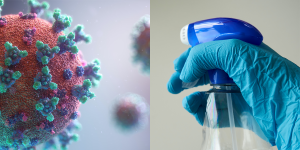Since COVID-19 hit, we’ve seen everything from “miracle” cleaners to practical, evidence-based processes and chemicals proven to kill the virus. Most notable is a group of products categorized as providing long-term bio protection, which has received a ton of hype.

But is that hype warranted? Spoiler alert: No. But before we go deeper, let’s align on how long-term bio protection is defined.
Long-term bio protection, at this moment, means a chemical can prevent bacteria and fungi from living on a surface for an extended period.
The concept is simple: Rather than applying a disinfectant after each time a surface is touched, a long-term bio protectant is positioned as a solution that only needs to be applied occasionally. It then acts as a “shield” against certain microscopic bacteria.
But, here’s the catch: Long-term bio protection doesn’t protect against COVID-19. It’s being positioned that way, but the science doesn’t align.
For multiple reasons, including its inability to prevent COVID-19 from surviving, we do not condone the use of long-term bio protectants when defending against the virus at this time.
Long-term bio protectants
What they do:
- Provide a microbiostatic agent that create an invisible “shield” to protect surfaces from bacteria and fungus that can corrode or damage material.
- Inhibits the growth of bacteria, fungi and algae.
- Prevents bacteria from staining or discoloring surfaces.
- Prevents odor-causing bacteria from growing.
- Approved only for residential.
What they don’t do:
- Kill or prevent COVID-19 on surfaces.
What the Environmental Protection Agency (EPA) says:
- Long-term bio protectants are not proven to kill COVID-19.
- They are not listed on the EPA’s “N” list, which provides disinfectants proven to kill COVID-19.
- No timeframe for how long the bio protectants last is listed.
Have more questions? Don’t hesitate to reach out to our chemical expert, Doug Lerch at [email protected]
